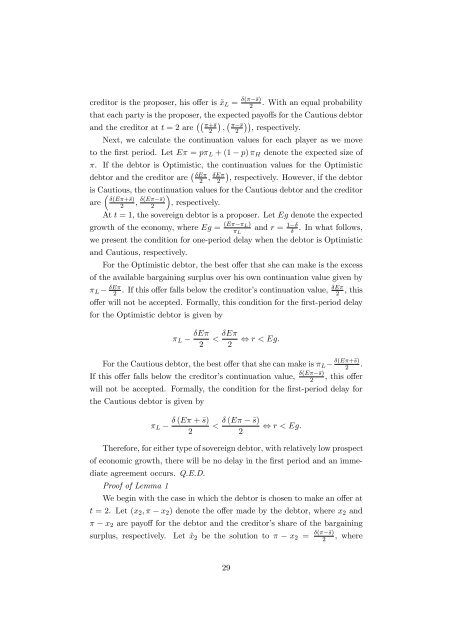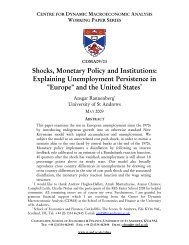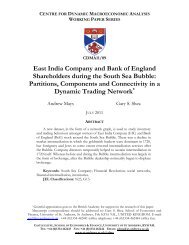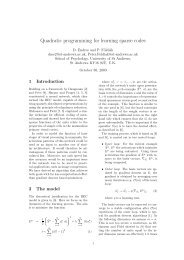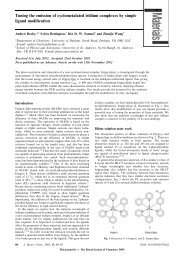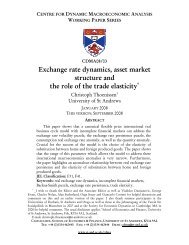Delay and Haircuts in Sovereign Debt - University of St Andrews
Delay and Haircuts in Sovereign Debt - University of St Andrews
Delay and Haircuts in Sovereign Debt - University of St Andrews
Create successful ePaper yourself
Turn your PDF publications into a flip-book with our unique Google optimized e-Paper software.
creditor is the proposer, his o¤er is ~x L = ( s)<br />
2<br />
. With an equal probability<br />
that each party is the proposer, the expected payo¤s for the Cautious debtor<br />
<br />
<strong>and</strong> the creditor at t = 2 are ;<br />
, respectively.<br />
+s<br />
2<br />
Next, we calculate the cont<strong>in</strong>uation values for each player as we move<br />
to the …rst period. Let E = p L + (1<br />
s<br />
2<br />
p) H denote the expected size <strong>of</strong><br />
. If the debtor is Optimistic, the cont<strong>in</strong>uation values for the Optimistic<br />
<br />
debtor <strong>and</strong> the creditor are<br />
, respectively. However, if the debtor<br />
<br />
(E+s)<br />
2<br />
;<br />
(E s)<br />
2<br />
E<br />
2 ; E<br />
2<br />
is Cautious, the cont<strong>in</strong>uation values for the Cautious debtor <strong>and</strong> the creditor<br />
are<br />
, respectively.<br />
At t = 1, the sovereign debtor is a proposer. Let Eg denote the expected<br />
growth <strong>of</strong> the economy, where Eg = (E L)<br />
L<br />
<strong>and</strong> r = 1 <br />
<br />
. In what follows,<br />
we present the condition for one-period delay when the debtor is Optimistic<br />
<strong>and</strong> Cautious, respectively.<br />
For the Optimistic debtor, the best o¤er that she can make is the excess<br />
<strong>of</strong> the available barga<strong>in</strong><strong>in</strong>g surplus over his own cont<strong>in</strong>uation value given by<br />
E<br />
E<br />
L 2<br />
. If this o¤er falls below the creditor’s cont<strong>in</strong>uation value,<br />
2 , this<br />
o¤er will not be accepted. Formally, this condition for the …rst-period delay<br />
for the Optimistic debtor is given by<br />
L<br />
E<br />
2<br />
< E<br />
2<br />
, r < Eg:<br />
(E+s)<br />
2<br />
.<br />
For the Cautious debtor, the best o¤er that she can make is L<br />
If this o¤er falls below the creditor’s cont<strong>in</strong>uation value, (E s)<br />
2<br />
, this o¤er<br />
will not be accepted. Formally, the condition for the …rst-period delay for<br />
the Cautious debtor is given by<br />
L<br />
(E + s)<br />
2<br />
<<br />
(E s)<br />
2<br />
, r < Eg:<br />
Therefore, for either type <strong>of</strong> sovereign debtor, with relatively low prospect<br />
<strong>of</strong> economic growth, there will be no delay <strong>in</strong> the …rst period <strong>and</strong> an immediate<br />
agreement occurs. Q.E.D.<br />
Pro<strong>of</strong> <strong>of</strong> Lemma 1<br />
We beg<strong>in</strong> with the case <strong>in</strong> which the debtor is chosen to make an o¤er at<br />
t = 2. Let (x 2 ; <br />
x 2 ) denote the o¤er made by the debtor, where x 2 <strong>and</strong><br />
x 2 are payo¤ for the debtor <strong>and</strong> the creditor’s share <strong>of</strong> the barga<strong>in</strong><strong>in</strong>g<br />
( s)<br />
surplus, respectively. Let ~x 2 be the solution to x 2 =<br />
2<br />
, where<br />
29


